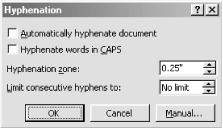Name
Tools → Language → Hyphenation
Synopsis
By default, if the word being typed at the right margin of a document doesn’t fit entirely on the line, the whole word is wrapped to the next line. This is normally acceptable, especially in single-column documents with left or full justification.
Word can hyphenate words that don’t fit entirely at the end of a line when typing in newspaper columns, using narrow margins or creating a document whose layout calls for strict double justification. This is helpful when text takes up a narrow horizontal space, because moving entire words down a line leaves unattractive whitespace at the end of lines.
Turn on hyphenation using Tools → Language → Hyphenation (Figure 9-4). Enable the “Automatically hyphenate document” option to turn on hyphenation.
Don’t Hyphenate Acronyms
If you type many acronyms (such as ACLU or ASPCA), make sure that the Tools → Language → Hyphenation → “Hyphenate words in CAPS” option is turned off. If it is on, you risk breaking these acronyms at the margin with a hyphen, which can be confusing to the reader.

Figure 9-4. Turning on hyphenation
Specify the Hyphenation zone — the space between the text and the right margin that the word must enter and not fit before it is hyphenated. The default setting is .25 inches. If there is less than .25” between the end of a word and the right margin, the word is hyphenated.
Enter a number ...
Get Word 2000 in a Nutshell now with the O’Reilly learning platform.
O’Reilly members experience books, live events, courses curated by job role, and more from O’Reilly and nearly 200 top publishers.

